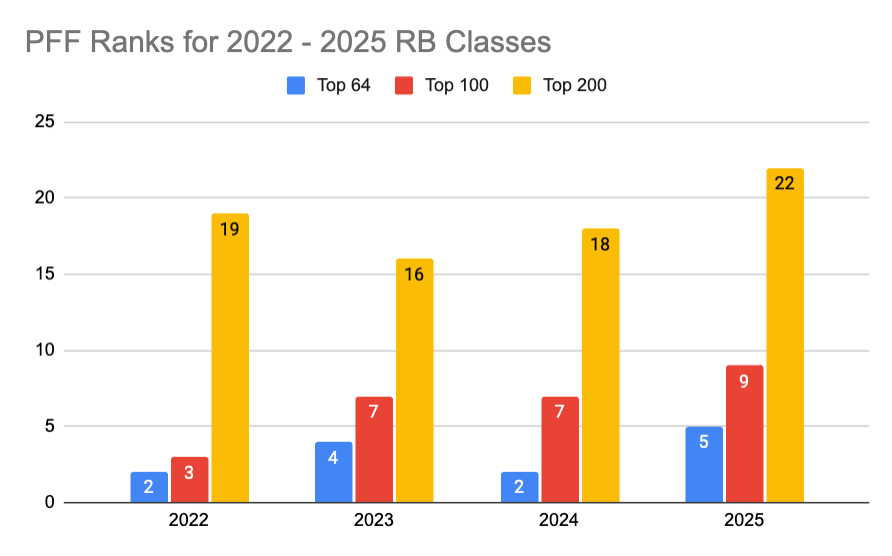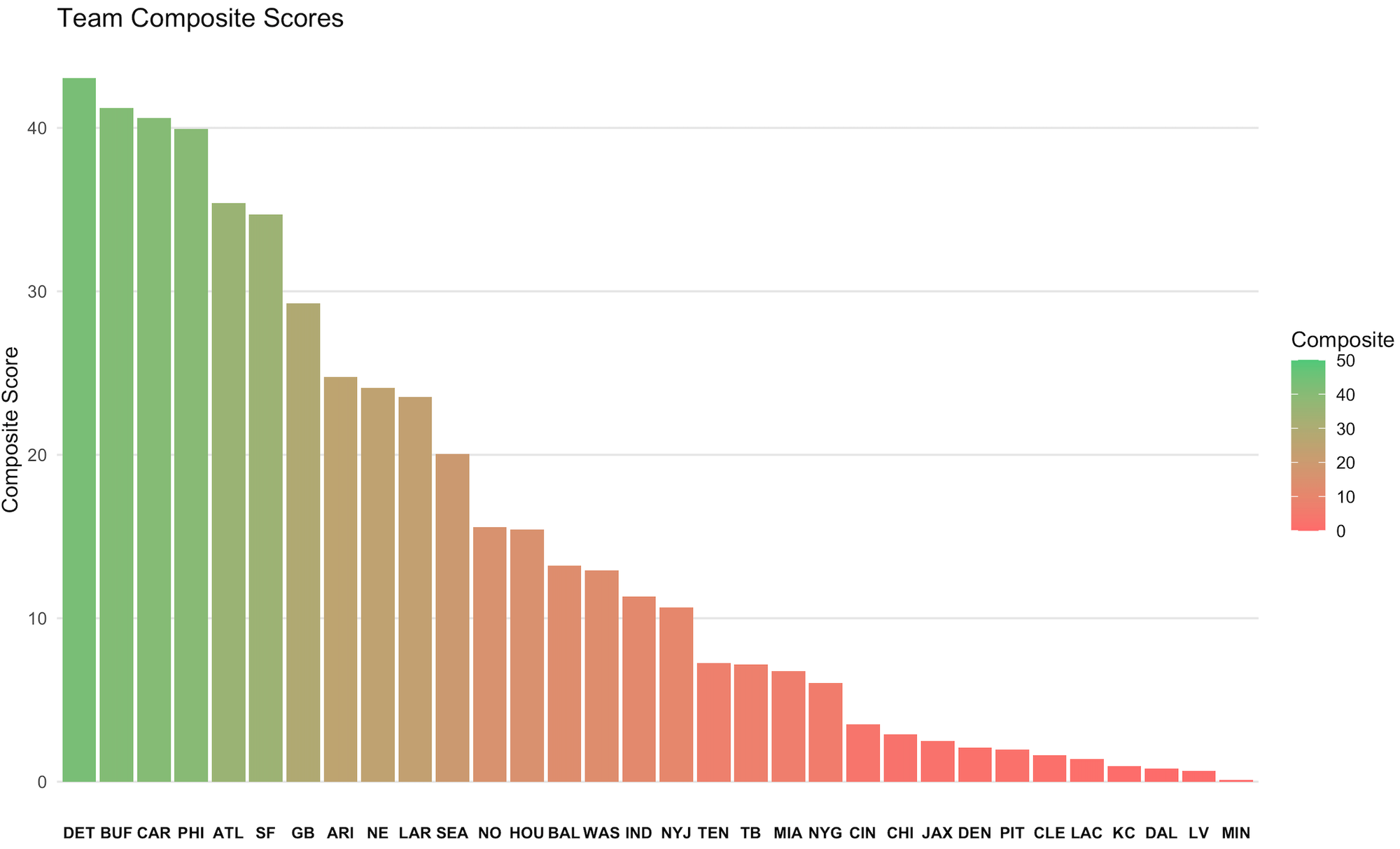
Navigating this Offseason's RB Minefield
2025's rookie running back class is loaded, and it's going to impact the fantasy football landscape.
Initial Intelligence Gathering
Every offseason, a significant portion of the available touches for NFL running backs transitions to the newest draft class. Similarly, some perceived-to-be incumbent starters will see their cozy spots as the No. 1 on a team's depth chart disappear as players like Najee Harris, (maybe) Aaron Jones, and (perhaps) J.K. Dobbins finagle themselves into coveted lead back positions.
You've probably heard that the 2025 free agent cohort of running backs is sub-standard. To fully illustrate the quality, I've blended Josh Queipo's well-researched contract projections with those from Pro Football Focus.
Najee Harris – $10.6 Million AAV
Aaron Jones – $7.25M AAV
JK Dobbins – $4.25M AAV
Last offseason, in an admittedly abnormally strong class, eight backs cleared 4.2 million dollars. This year, with a salary cap ~8% higher, we are likely to see NFL teams allocate their free agent dollars to other positions. The rest of the free agent class contains the likes of Rico Dowdle, Nick Chubb, Javonte Williams, Kareem Hunt, Samaje Perine, Ty Johnson, and Alexander Mattison. It's dire.
Luckily, the call for reinforcements will not go unanswered.
The Cavalry Is Arriving Via The Draft
While the free agent class leaves much to be desired, the incoming group of collegiate running backs, simply put, rocks. The past three NFL draft classes have seen between 16 and 19 backs listed in the PFF BigBoard top 200 (a very strong predictor of how the NFL will attack the position across the entire draft).
In 2025, PFF has 22 backs in their top 200.

Plainly, compared to the previous three classes, 2025's RB class has the most high-end talent, mid-tier talent, and depth. Even with an average-quality free agent back class, run-first teams would likely attack this RB class with the ferocity of a thousand winds. Given the weak FA group, we might want to adjust it up to two thousand winds. Reasonably, we could see over half the teams in the NFL spend at least a fifth-round pick on a running back.
All Models Are Wrong. Some Models Are Useful
To try and capture how each team should feel about their current running back room before the offseason, I set out to answer a few instructive questions.
Before free agency and the draft, who are the running backs each team has under contract?
How much has each team invested in their current running back room?
How skilled is each team's current running back room?
After combing through copious amounts of contract data, rushing, receiving, and blocking metrics, and the past three NFL drafts, I think I have estimated how each team feels about their backfield decently well.
Methodology
Before displaying the model, allow me to briefly walk through the process. To quantify the skill of a running back room, I combined the following qualities of a team's top two listed under-contract backs:
- PFF Rushing grade & Rush Yards Over Expected Per Game (to capture rushing quality)
- Yards Per Route Run (to capture receiving quality)
- PFF Blocking grade (to capture blocking quality)
Each qualifying back in the group had their grades in each category converted to a percent rank relative to the entire cohort of listed starting and backup backs. For teams where a second-string back was not under contract, or teams where such a back did not qualify for metrics due to insufficient volume (think Malik Davis, Salvon Ahmed), their second-string was treated as if they did not have a player under roster, with the general thinking that if a player failed to generate touches in 2024, the team would not be eager to rely on them in 2025.
Starter percent ranks across the three categories were weighted 3x as much as backup grades, with skill percent ranks weighted in the following order, albeit with slightly different proportions, (i) Rushing percent rank (ii) YPPR percent rank (iii) Blocking percent rank. Rushing percent rank was slightly de-emphasized and YPRR and Blocking received slightly higher weights for second-string backs under the assumption that teams will rely on second-stringers for more specialized situations more often. This change marginally impacted the results.
From here, we have a collective 'skill' grade for each of the thirty-two teams. Here's how those came out.

The top ten: BAL (#1) DET, ATL, TB, PHI, BUF, ARI, HOU, CAR, SEA
The bottom ten: JAX, IND, DEN, NYG, KC, CHI, LAC, DAL, MIN, LV (#32)
Which Teams Are Willing to Invest at RB?
Now that we have a rough approximation of team-talent, let's look at NFL investment in the position. To do this, we need to find:
Each team's total cap hit at RB
The remaining length on all contracts
The draft capital associated with rookie-wage contracts
Which teams have new general managers or powerful new head coaches that may be less attached to talent drafted by previous regimes
Which players that have one year left on their rookie-wage contracts do we believe are strong extension candidates this offseason
Which players were UDFAs or RFAs and need special consideration (Jaylen Warren, Jaleel McLaughlin)
To find cap hit and length remaining on contracts, we can rely on Spotrac contract data. To achieve a valuation of draft capital, we can access the Fitzgerald-Spielberger draft chart. To adjust for general manager and coach changes, we can adjust for which teams have new management.
It also bears mentioning I've treated Chicago's hiring of Ben Johnson as a general manager change due to his likely increased power in offensive personnel decisions relative to the average coach and, most importantly, his certain disdain for D'Andre Swift. Additionally, since Brian Callahan had supported signing Tony Pollard during the 2024 offseason, I didn't dock Pollard's contract for the Titans' new general manager.
I then adjusted the collective contract and draft capital investment for each franchise for the remaining length of said contracts. For example, I'm treating players like Chuba Hubbard and Rhamondre Stevenson, who recently received four-year extensions ending after the 2028 season, as twice the investment of a player with an identical contract terminating after the 2026 season (Joe Mixon, James Conner). Draft pick value per the FSDC was converted to a (rough) approximation of contract value.
Which RBs are About to Get Paid?
Some RBs aren't yet free agents but are still about to get new contracts.
For the 2022 RB class, it's extension szn. Here are the assumptions I made:
James Cook: 3 year extension worth 42 million dollars at extremely strong likelihood
Breece Hall and Kyren Williams: 3 year extensions worth 42 million dollars at a strong likelihood
Brian Robinson Jr: 3 year extension worth 30 million dollars at a strong likelihood
Tyler Allgeier: 2 year extension worth 18 million dollars at a coinflip likelihood
Kenneth Walker III: 3 year extension worth 36 million dollars at below coinflip likelihood
Jaylen Warren will likely receive a one-year contract worth around $3M as a restricted free agent, so that is the contract I replaced his UDFA status with. I treated Jaleel McLaughlin, with one year left on his UDFA deal, like a seventh-round draft pick on an expiring contract.
Also worth noting, Saquon Barkley can re-negotiate his contract and I made a slight adjustment to increase the AAV and add one more year to his contract.
With team investment and the few outliers accounted for, we can then multiply each team's investment in the position by the 2024 skill grade their backs accounted for.
Now, for the actionable stuff.
In tiers, let's break down all thirty-two teams, their likely approach to the running back position this offseason, and whether current ADPs match likely approaches.
We have already incorporated all the below analysis into the LegUp ranks!
Looking At the ADP Landscape
So, now that we have the running back environment covered and extension candidates fictitiously signed, we can multiply each team's positional 'skill grade' by their 'investment grade.'
Voila!

Now, let's think about which ADPs have the most fragility with respect to a backfield add complicating the picture.
Tier 1: As Low-Risk As You Can Get
Detroit Lions
The Lions have one of the most-talented and highest-investment backfields in the league. Jahmyr Gibbs has played his way into a lucrative extension once he becomes eligible and David Montgomery's contract expires after 2027. Do not expect meaningful offseason investment in the RB position. Their ADPs make sense.


